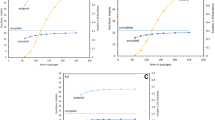Summary
Doublet preference analysis was carried out on coding and noncoding regions ofEscherichia coli, Saccharomyces cerevisiae, and human mitochondrial and nuclear DNA. The preference pattern in 1–2 and 2–3 doublets inE. coli andS. cerevisiae correlated with that in noncoding regions. The 3-1 doublet preference inE. coli genes with low optimal codon frequency and inS. cerevisiae genes also showed a correlation with each of their noncoding doublet preference. A mechanism to explain these double preference correlations in doublet preference is presented: mutational biases, the origin of the noncoding region doublet preference, evolved so as to maintain the 1–2 and 2–3 doublet preference, which is determined by codon usage. These biases then acted on the 3-1 doublet, which was almost free of coding constraints, resulting in a similar preference in this doublet.
Similar content being viewed by others
References
Anderson S, Bankier AT, Barrell BG, de Bruijn MHL, Coulson AR, Drouin J, Eperon IC, Nielich DP, Roe BA, Sanger F, Schreier PH, Smith AJH, Staden R, Young IG (1981) Sequence and organization of the human mitochondrial genome. Nature 290:457–465
Aota S-I, Ikemura T (1986) Diversity in G+C content at the third letter position of codons in vertebrate genes and its cause. Nucleic Acids Res 14:6345–6355, 8702 (erratum)
Bernardi G, Olofsson B, Filipski J, Zerial M, Salinas J, Cury G, Meunier-Rotival M, Rodier F (1985) The mosaic genome of warm-blooded vertebrates. Science 228:953–958
Bird AP (1980) DNA methylation and the frequency of CpG in animal DNA. Nucleic Acids Res 8:1499–1504
Blake RD, Earley S (1986) Distribution and evolution of sequence characteristics in theE. coli genome. J Biomol Struct & Dyn 4:291–307
Gouy M (1987) Codon contexts in enterobacterial and coliphage genes. Mol Biol Evol 4:426–444
Grantham R, Gautier C, Gouy M, Mercier R, Pave A (1980) Codon catalog usage and the genome hypothesis. Nucleic Acids Res 8:449–62
Guttman I, Wilks SS, Hunter JS (1982) Introductory engineering statistics, ed 3. John Wiley & Sons, New York
Hanai R, Wada A (1988) The effects of guanine and cytosine variation on dinucleotide frequency and amino acid composition in the human genome. J Mol Evol 27:321–325
Hanai R, Wada A (1989) Novel third-letter bias inEscherichia coli codons revealed by rigorous treatment of coding constraints. J Mol Biol 208:207, 655–660
Ikemura T (1985) Codon usage and tRNA content in unicellular and multicellular organisms. Mol Biol Evol 2:13–34
Ikemura T, Aota S-I (1988) Global variation in G+C content along vertebrate genome DNA. Possible correlation with chromosome band structure. J Mol Biol 203:1–13
Jukes TH (1978) Codons and nearest-neighbor nucleotide pairs in mammalian messenger RNA. J Mol Evol 11:121–127
Kimura M (1983) The neutral theory of molecular evolution. Cambridge University Press, Cambridge
Konigsberg W, Godson N (1983) Evidence for use of rare codons in the dnaG gene and other regulatory genes ofEscherichia coli. Proc Natl Acad Sci USA 80:687–691.
Lewin B (1985) Genes. Wiley, New York
Nussinov R (1981a) Eukaryotic dinucleotide preference rules and their implications for degenerate codon usage. J Mol Biol 149:125–131
Nussinov R (1981b) The universal dinucleotide asymmetry rules in DNA and the amino acid codon choice. J Mol Evol 17:237–244
Nussinov R (1984) Strong doublet preferences in nucleotide sequence and DNA geometry. J Mol Evol 20:111–119
Osawa S, Jukes TH, Muto A, Yamao F, Ohama T, Andachi Y (1987) Role of GC/AT-biased mutation pressure in evolution of eubacterial code. Cold Spring Harbor Symp Quant Biol 52: 777–789
Russel GJ, McGeoch DJ, Elton RA, Subak-Sharpe JH (1973) Doublet frequency analysis of bacterial DNAs. J Mol Evol 2: 277–292
Sharp PM, Cowe E, Higgins DG, Shields DC, Wolfe KH, Wright F (1988) Codon usage patterns inEscherichia coli, Bacillus subtilis, Saccharomyces cerevisiae, Schizosaccharomyces pombe, Drosophila melanogaster, andHomo sapiens; a review of the considerable within-species diversity. Nucleic Acids Res 16:8207–8211
Shields DC, Sharp PM (1987) Synonymous codon usage inBacillis subtilis reflects both translational selection and mutational biases. Nucleic Acids Res 15:8023–8040
Shpaer EG (1986) Constraints on codon context inEscherichia coli genes. Their possible role in modulating the effiency of translation. J Mol Biol 188:555–564
Subak-Sharpe H, Burk RR, Crawford LV, Morrison JM, Hay J, Keir HM (1966) An approach to evolutionary relationships of mammalian DNA viruses through analysis of the pattern of nearest neighbor base sequences. Cold Spring Harbor Symp Quant Biol 31:737–748
Sueoka N (1962) On the genetic basis of variation and heterogeneity of DNA base composition. Proc Natl Acad Sci USA 48:582–592
Swartz MN, Trautner TA, Kornberg A (1962) Enzymatic synthesis of deoxyribonucleic acid: xi. Further studies on the nearest neighbor base sequences in deoxyribonucleic acids. J Biol Chem 237:1961–1967
Wada A, Suyama A (1985) Third letters in codons counterbalance the (G+C)-content of their first and second letters. FEBS Lett 188:291–294
Wu C-I, Maeda N (1987) Inequality in mutation rates of the two strands of DNA. Nature 327:169–170
Yarus M, Folley LS (1985) Sense codons are found in specific context. J Mol Biol 182:529–540
Author information
Authors and Affiliations
Rights and permissions
About this article
Cite this article
Hanai, R., Wada, A. Doublet preference and gene evolution. J Mol Evol 30, 109–115 (1990). https://doi.org/10.1007/BF02099937
Received:
Revised:
Issue Date:
DOI: https://doi.org/10.1007/BF02099937




